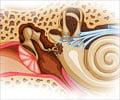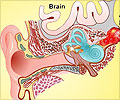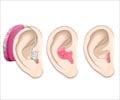Dizziness caused by loose crystals — or ear rocks — in the inner ear is more common among older adults. The problem could be treated with a series of simple head movements.
Dizziness caused by loose crystals — or ear rocks — in the inner ear is more common among older adults. The problem could be treated with a series of simple head movements.
Such movements help put dislodged ear rocks back where they came. Eventually they are cleared away by the immune system. The condition is known as benign paroxysmal positional vertigo, or BPPV.Within the inner ear, there's a little pouch called the utricle that contains about 1,000 little pebbles made of calcium carbonate.
The tiny rocks serve an important purpose: They stimulate nerve cells when we move our heads — and send signals to our brain that guide our sense of up and down.
"The trouble is that sometimes the little rocks fall off," explains Dr. Timothy Hain, a dizziness expert at Northwestern University. When the rocks fall into one of the inner ear canals, the brain gets confused. As the rocks roll around in the canal, the brain senses that the head is moving a lot more than it actually is. The result: vertigo.
Head injuries and viruses can trigger the "rock slide" seen in BPPV. But several studies also document that the condition is more prevalent among adults over age 50, Allison Aubrey reported for National People’s Radio.
The main strategy used to move the rocks out of the canal is called the Epley maneuver. It was first introduced in the late 1980s, and has since been adopted by many ear specialists, neurologists, physical therapists and audiologists.
Advertisement
"It's not successful all the time," says Strieb. "Sometimes it takes repeat visits."
The dizziness usually comes on suddenly. For Adele Freed, 83, of Frankfort, Ill., the sensation was similar to being tipsy from alcohol.
"I remember everything was spinning," she recalls. "And when I tried to get out of bed, the walls were moving. I just didn't have any balance."
Freed's family medical doctor gave her a prescription of Meclizine to treat the dizziness. When she didn't improve, she went to Hain, who's known at Northwestern University as the dizziness doc. He diagnosed her with BPPV.
The condition is not uncommon. About 1 in every 5 patients referred to him has this condition. And some researchers estimate that about 50 percent of all dizziness in older people is due to BPPV.
"This is really a success story in medicine," says Hain. "We've figured out the cause of this condition — and we've figured out how to treat it."
Freed was relieved to learn that the dizziness could be relieved by a series of simple movements that take about 15 minutes. A physical therapist guided her through the maneuver. Hain also gives patients exercises to do at home. The goal is to dislodge the rocks from the canal, and get them back where they belong.
"I was amazed that the whole secret to what I had was to get those crystals back in place," says Freed.
For those who seek no treatment at all, the condition usually improves on its own within a few months.
In severe cases, where the symptoms linger, physicians can perform a surgery to plug the ear canal.
Source-Medindia
GPL/L












